Click below to find other Scottish Clans
|
|
|
|
| The Malcolm and MacCallum clan history is rather confusing when trying to establish the origins. It always comes down to the question: Are they the same clan or not? People have argued about this for many years. Traditionally the family are said to have lived in the area of Argyll at a very early time in Scottish history. When we look at King David the second and King Robert the second charters were given to the people called Malcolm in Stirlingshire. We see that their territory was more in the Loch Awe area. Again according to history this family were said to be an off-shoot of the MacGhille Challums (or MacLeods of Raasay). If we break the name down and look at it in Gaelic perhaps we will have a better idea as to its origin. Maol is Gaelic for shaven head (maybe a monk) Gillie in the Gaelic means young man or servant of. The first syllables of Malcom tell us that he is a (servant of Colm) or indeed Gillanders meaning he is a (servant of Andrew). The names appear to be very interchangeable although the original meaning of both is not. |
|
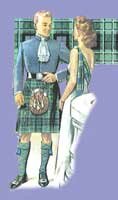 |
There is a difference when you look at the two names Malcolm and MacCallum. They are sometimes shown as alternatives for the same name the same clan. But there is an essential difference between a devotee of Callum (or Colm) and a son of Callum. So therefore it is not so easy to link the two family names. To throw even more confusion to the subject, some people claim the name comes from Iona and is directly linked to Saint Columba as where the family lived in Lorn was only a few miles from the island where Columba landed in 561AD.
In 1414 Sir Duncan Campbell of Lochow granted certain lands to Reginald MacCallum of Corbarron. He was also given the office of Hereditary Constable of the castle of Lochaffy and Craignish. Unfortunately this branch of the family clan died out.
|
|
Another branch of the family was changing their names on a permanent basis in 1779. Dugald MacCallum of Poltalloch inherited the estate then, and was the first to adopt the name Malcolm over his original name MacCallum.
There was another member of the family of Malcolm who became well known. Admiral Sir Pulteney Malcolm was Commander in Chief of St. Helena and was so good at what he done that even the Emperor Napoleon held him in very high regard.
John Wingfield Malcolm of Poltalloch was created Lord Malcolm in the year 1896, but the peerage became extinct when he died in 1902. His brother did inherit the estate and the feudal title Malcolm of Poltalloch; he also inherited the Chieftainship of clan Malcolm. There was a further confusion to the history of the Malcolm/MacCallum family clan. The tartan of the clan had been adjusted in the eighteenth century causing the clan to lose its true identity. This has been put to rights and the tartan depicted on this page has been authenticated as correct by Sir Ian Malcolm of Poltalloch.
|
|
Chief: Malcolm of Poltalloch
Clan Seat: Poltalloch, Argyll
Plant: Rowan Berries
Memorials : None
|
|
| Back to Top |
|
The name Matheson comes from the Gaelic MacMathain , or Mac-mhaghan , and literally means, " son of the bear " not to be confused with the English Matthewson which is simply 'Son of Matthew'. It is not sure whether the Mathesons are of pure Celtic blood but with the strong Norse influence in the family it is more than likely that there will be much of their blood which is of the Celtic variety.
The MacMathans were settled in Lochalsh in Wester Ross from an early period. Kenneth MacMathan, constable of Eilean Donan is recorded in both the Norse account of the expedition of King Haakon IV against Scotland in the year of 1263, and in the Chamberlain Rolls of that same year, which culminated in the defeat of King Haakon at the Battle of Largs.
|
|
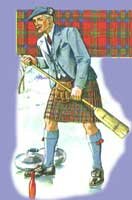 |
The Mathesons fought for Donald of the Isles at the battle of Harlaw in the year of 1411 and afterwards Chief Alastair, leader of 2000 men, was arrested by James the first, at Inverness and beheaded in Edinburgh in the year of 1427. He had two sons; John from whom the Mathesons of Lochalsh descend and Donald Bain from whom the Sutherland Mathesons, " Siol Wohan" descend. John, was constable of Eilean Donan Castle under Mackenzie, the ninth of Kintail, and was killed defending the fortress against the MacDonalds of Sleat in the year of 1539. His grandson Murdoch Buidhe had two sons Roderick of Fernaig and Dugald an Oir of Balmacarra. John (Ian mor), son of Roderick bought Bennetsfield on the Black Isle around the year 1688, and with his family left Lochalsh. |
|
The Chiefship remained in this family, the Mathesons of Bennetsfield until the year of 1975 when the then chief Colonel Bertram Matheson of Matheson, M.C. died without issue. Dugald an Oir was the progenitor of the Mathesons of Attadale and Lochalsh, Alexander of that family who was born in the year of 1805, bought back the Lochalsh estate in 1851 and was created Baronet of Lochalsh in 1882. His grandson Major Torquhil Matheson of Matheson, 6th Baronet of Lochalsh succeeded Colonel Bertram by Tanistry. From the Sutherland Mathesons descend Sir James Matheson of the Shiness branch. He joined the well-known mercantile house of Jardine, Matheson and Co. of India and China where he amassed a large fortune. He bought the island of Lewis and was created the Baronet of Lewis in 1851 for his exertions and generosity in alleviating the sufferings of the inhabitants of the island during a period of famine. Descendants of the Lochalsh and Siol Wohan Mathesons are to be found today in Australia , Canada , U.S.A. and New Zealand .
|
|
Chief: Matheson of Matheson
Clan Seat: Acha-�n-da-thearnaid
Plant: Four Petal Rose
|
|
| Back to Top |
| The Maxwell's are a Border clan and were active during the turbulent Border wars. The first leader was Maccus, who was the older son of Undweyn, and who lived in the twelfth Century who appears to have given his name to Maccuswell, a pool of the Tweed near Kelso Bridge ; Wael is old English for pool. His descendant Sir John Maxwell was appointed Chamberlain of Scotland but died without issue in the year of 1241. He was the first to occupy the Maxwell's great castle of Caerlaverock . He was succeeded by his brother Sir Aymer who had two sons, Herbert and John. From these two brothers descend many branches of the Maxwell clan. |
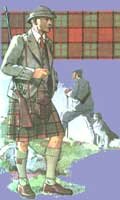 |
|
Sir Herbert of Maxwell was one of the nobles who recognized Margaret of Norway as Queen of Scots and John Balliol as King. His grandson, Sir Eustace held Caerlaverock for Edward the first in the year of 1312 but he later signed The Declaration of Arbroath in 1320. He returned to Balliol's camp briefly but then followed the Bruces.
He was with the Scottish army on the twenty- fourth of June in the year 1314, when King Robert the Bruce of Scotland defeated a numerically superior English army. The English had been lead by Edward the second on to the fields of Bannockburn near the historic Scots town of Stirling . The defeated army scattered back to their homeland after the battle finished. His brother and son also followed David II to the field in the year of 1346. Herbert his successor was knighted Lord Maxwell after James the first returned in the year of 1424 and he became increasingly more powerful during the fifteenth century after the decline of the Black Douglas, and became Warden of the Marches . John, Lord Maxwell in the reign of King James the fourth was imprisoned for lawlessness but later died with his King at Flodden in the year of 1513. He had two sons, Robert, who became the fifth Lord and John who became Lord Herries of Terregles by marrying Lady Anne Herries. His brother served briefly as Regent during King James the fifth's reign and escorted Queen Mary of Lorraine to Scotland in the year of 1538. In 1581, John, Lord Maxwell was created Earl of Morton after the execution of the Douglas holder, he was killed in an engagement with the Johnston 's in the year 1593. His son also John, in revenge killed Sir James Johnston of that Ilk in 1608 and fled to the continent, only to be executed on his return in 1613. He was succeeded by his brother Robert who was created Earl of Nithsdale (the title of Earl of Morton was restored to the Douglases ). The title reverted to Lord Herries when the direct line ended. The fifth Earl joined the Jacobite Struggle for truth in the year of 1715, and fought bravely at the battle of Culloden. He was captured and sentenced to death, he escaped from the Tower of London dressed in female attire and then he travelled to Rome where he was forced to live in poverty until his death. Other Maxwell families include those of Pollock, Monteith, Cardoness and Corruchan. William Maxwell of Corruchan established in Lyon Court his claim as heir male of the Maxwells.
|
|
Chief: Unknown at this time
Clan Seat: Caerlaverock Castle, Dumfries-shire
Plant: Not Known Memorials: None
|
|
| Back to Top |
| The family of Menzies obtained a footing in Atholl at a very early period in Scotland 's ancient history, and it appears from a charter granted by Robert de Meyners in the reign of Alexander the second. This Robert de Meyners, knight, on the accession of Alexander the third (1249) was appointed Lord High Chamberlain of Scotland . His son, Alexander de Meyners, possessed the lands of Weem and Aberfeldy in Atholl, and Glendochart in Bredalbane, besides his original seat of Durrisdeer in Nithsdale, and he was succeeded by his eldest son, Robert, in the estates of Weem, Aberfeldy, and Durrisdeer, whilst his second son, Thomas, obtained the lands of Fortingal. |
|
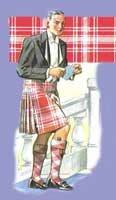 |
From the former of these is descended the family of Menzies of Castle Menzies, but that of Menzies of Fortingal terminated in an heiress, by whose marriage with James Stewart, a natural son of the Wolf of Badenoch, the property was transferred to the Stewarts.
In 1487, Sir Robert de Mengues, knight, obtained from the crown, in consequence of the destruction of his mansion-house by fire, a grant of a the whole lands and estates erected into a free barony, under the title of the barony of Menzies. From this Sir Robert lineally descended Sir Alexander Menzies of Castle Menzies, who was created a baronet of Nova Scotia , second of September 1665. The clan fought for Bruce at the battle of Bannockburn in the year 1314 when the English were defeated and Scotland was free once more.
|
|
The "Menzies" of Atholl and Appin Dull are named in the parliamentary rolls of 1587, as among "the clans that have captains, chiefs, and chieftains". Castle Menzies, the principal modern seat of the chief, stands to the east of Loch Tay, in the parish and near to the church of Weem , in Perthshire. Weem Castle , the old mansion, is picturesquely situated under a rock, called Craig Uamh, hence its name.
In 1644, when the Marquis of Montrose appeared in arms for Charles I, and had commenced his march from Atholl towards Strathearn, he sent forward a trumpeter, with a friendly notice to the Menzies, that it was his intention to pass through their country. His messenger, unhappily, was maltreated, and, as some writers say, slain by them. They also harassed the rear of his army, which so exasperated Montrose, that he ordered his men to plunder and lay waste their lands and burn their houses. The clan fought for the Jacobite Struggle for truth in both the years of 1715 and 1745.
The last laird, John Menzies of Pitfoddels, never married, and devoted the greater part of his large estate to the endowment of a Roman Catholic College. He died in 1843.
|
|
Chief: Menzies of that Ilk
Clan Seat: Castle-Menzies, Weem, Aberfeldy
Plant: Menzies Heath
Memorials: Auld Kirk o' Weem
|
|
| Back to Top |
|
The Chlann Mhic-Ghille-Mhuire, meaning " Devotee of St. Mary " or Morrison clan is said to be Scandinavian in origin, supposedly descending from the natural son of the King of Norway who was shipwrecked of the shores of Lewis away back in Scotland 's distant history. This is the Morrison clan whereas the Morrison's of the Central Highlands, "sons of Maurice", and the Morrison's who descend from the O'Muirgheasain bards from Ireland who settled in Harris have no connection with the Hebridean clan of Lewis. This clan from the Irish islands were said to be the hereditary keepers of the holy relics of Saint Columcille at Clonmany. The Morrison chiefs once held the hereditary office of Brilheanh, brieve or judgement, under the MacLeods from whom they held Habost in north Lewis. This entitled the family to certain privileges, and they lorded over their fellow clansmen.
The first recorded Morrison is Uisdean of Hugh who lived in the sixteenth century, a contemporary of the last Macleod of Lewis, Roderick, who was chief till about the year 1595. He is said to have incurred their wrath when he betrayed Torquil Dubh Macleod, who was beheaded by the Mackenzie's in the year 1597. The Morrison's consequently had to seek refuge on the mainland and about sixty families of Morrison's are said to have settled in the vicinity of Durness in the Mackay country, accounting for the similarity of the Morrison and Mackay tartans. They lost the hereditary brieveship of Lewis in the year of 1613 when they resisted the takeover by the Mackenzie's, and by the nineteenth century it became impossible to even trace the line. Branches of the clan, the Morrisons in Pabbay of Harris were the hereditary smiths and armourers to the MacLeods of Harris.
Donald Morrison of Skinidin, Skye, married a daughter of John Breac Macleod of MacLeod. The most noted of this side to the Morrison family was Captain Alexander Morrison who personally assisted � Ossian MacPherson �
John Morrison of this family was a celebrated poet and wit of the nineteenth century. The Morrison's of Ruchdi in North Uist are descendants of the Morrison's of Pabbay and on petition of the Lyon Court were reinvested in arms as the chiefs of Clan Morrison.
The Morrison clan is still a centrally important family to the people of the Hebrides and the North Western parts of Scotland .
|
|
Chief: Morrison of Ruchdi
Clan Seat: Duneystein Castle , Isle of Lewis; Dun of Pabbay of Tarbert, in Harris
Plant: Driftweed
Memorials: None
|
|
| Back to Top |
|
The possessions of the clan Monro or Munro, situated on the north side of Cromarty Firth, were generally know in the Highlands by the name of Fearrann Donull or Donald's country, being so called, it is said, from the progenitor of the clan, Donald the son of O'Ceann, who lived in the time of Macbeth the well known King from the literary world. The Munroe's were vassals of the Earls of Ross, and may be regarded as a portion of the truly native Scottish Gael.
It has been suggested that the Munro family clan came originally from the north of Ireland with the MacDonalds, on which great clan "they had constantly a depending".
|
|
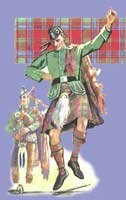 |
Their name it is said is to have been derived from "a mount on the river Roe", county Derry in Northern Ireland ( Ulster ). Clan tradition, probably not more to be relied upon than tradition generally, hold that they formed a branch of the natives of Scotland who, about the year 357A.D. were being driven out by the Roman army legions, and forced to take refuge in Ireland. The family it is said were located for several centuries on the stream of the Roe, and among the adjacent mountains.
In the time of Malcolm the second, or beginning of the eleventh century, the ancestors of the Munroe's are said to have come over to Scotland to aid in expelling the Danes, under the above named Donald, son of O'Ceann, who, for his services, received the lands of East Dingwall in Ross-shire.
|
|
These lands, erected into a barony, were denominated Foulis, from Loch Foyle in Ireland , and the chief of the clan was designated of Foulis, his residence in the parish of Kiltearn, near the mountain called Ben Uaish or Ben Wyvis. So says tradition.
Hugh Munro, the first of the family authentically designated of Foulis, died in the year 1126. He seems to have been the grandson of Donald, the son of O'Ceann above mentioned. Robert, reckoned the second baron of Foulis, was actively engaged in the wars of David I and Malcolm IV. Donald, heir to Robert, built the old tower of Foulis .
Sir Robert Munro, the sixth of his house, fought in the army of Bruce at the battle of Bannockburn . His only son, George, fell there, leaving an heir, who succeeded his grandfather. This George Munro of Foulis was slain at Halidonhill in 1333. The same year, according to Sir Robert Gordon, although Shaw makes the date 1454, occurred the remarkable event which led to a feud between the Munroe's and Mackintoshes.
Sir Robert left a son, Sir Harry Munro, seventh baronet and twenty-fifth baron of Foulis, an eminent scholar and a M.P
During the 17th century, the Munroe's fought in the continental wars and Robert 18th chief joined the army of Gustavus Adolphus, raising 700 of his own clan for service in Sweden and Denmark in defence of Protestantism. He greatly distinguished himself and his Scots received the name of the "Invincible". The Munroe's supported the government during the Jacobite uprisings and it was Munro of Foulis who was one of the original commanders of the six independent companies when they were raised in 1725. In 1740 when the companies of the "Black Watch" were formed into the 43rd (and later 42nd) Regiment, Sir Robert Munro, 6th Bart was appointed Lieutenant Colonel. This tradition of distinction in military service was to continue throughout the 19th and 20th centuries. Captain Patrick Munro of Foulis had the family seat of Foulis castle in Ross-shire and after his death c1990's Hector Munro succeeded him as Chief of the Clan.
|
|
Chief: Munro of Foulis
Clan Seat: Foulis Castle , Evanton, Ross-shire
Plant: Common Club Moss Memorial: None
|
|
| Back to Top |
|
The great Scottish family clan of Murray or Moray, occasions in the very old deeds the name can even be spelt Murref. The name is supposed to have descended from Freskine (or Friskin), who was said to be a Fleming, who settled in Scotland in the reign of David the first in the years-1122-1153, he acquired from that monarch the lands of Strathbroch in Linlithgowshire, and of Duffis in Moray. William de Moravia, who was Friskin's grandson, , married the heiress and daughter of David de Olifard, who was the direct descendent of the Morays of Bothwell and Abercairny, they were represented by the latter till the death of the late Major William Moray Stirling in the year of 1850. The property passed to his sister Mrs. Home Drummond of Blair Drummond when the male line became extinct,
|
|
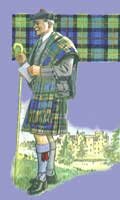 |
His descendant, the seventh in possession, Sir William Murray of Tullibardine, succeeded to the estates of his family in the year1446. He was sheriff of Perthshire, and in 1458 one of the lords named for the administration of justice, who were of the king's daily council. He married Margaret, daughter of Sir John Colquhoun of Luss, great chamberlain of Scotland , by whom he had numerous issues.
An interesting story about the huge family is that, According to tradition, they had seventeen sons, from whom a great many families of the name of Murray are descended.
|
|
In a strange document entitled "The Declaration of George Halley, in Ochterarder, concerning the Laird of Tullibardine's seventeen sons � in the year 1710", it is stated that they "lived all to be men, and that they waited all one day upon their father near to the Scottish town of Stirling, to attend the king, with each of them one servant, and their father two. This happening shortly after an Act was made by King James Fifth, discharging any person to travel with great numbers of attendants besides their own family, and having challenged the laird of Tullibardine for breaking the said Act, Sir William answered he brought only his own sons, with their necessary attendants; with which the king was so well pleased that he gave them small lands in heritage".
Sir John Murray, the twelfth feudal baron of Tullibardine, was brought up with King James, who in the year 1592 constituted him his master of the household. On tenth day of July 1606 he was created Earl of Tullibardine. His lordship married Catherine, fourth daughter of David, second Lord Drummond, and died in the year1609.
John, the second Marquis and first Duke of Athole, then designated Lord Murray, was one of the commissioners for inquiring into the massacre of Glencoe in 1693. He was created a peer in his father's lifetime, by the title of Earl of Tullibardine, Viscount of Glenalmond, and Lord Murray, for life, by patent dated the twenty-seventh of July 1696 , and in April 1703 he was appointed lord privy seal. On the 30th July of that year, immediately after his father's death, he was created Duke of Athole by Queen Anne, and invested with the order of the Thistle. His grace died fourteenth of November 1724. Although Murray of Atholl was not officially �out' for the Jacobite cause they did have men there. Lord George Murray was a leading Jacobite General. There is a saying that if Charles Edward Stewart had just went to sleep and left everything to Murray , he would have woken to the British Crown being placed on his head.
|
|
Chief: Duke of Atholl
Clan Seat: Blair Castle , Blair Atholl, Perthshire; Tullibardine, Perthshire
Plant: Juniper
Memorials: Tullibardine's Old Kirk
|
|
Click below to find other Scottish Clans
|
|
Back to Top
|